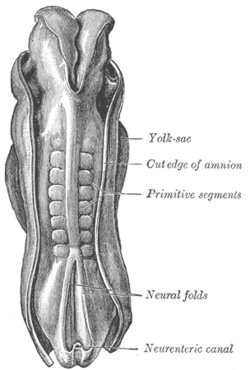
Back جسيدة Arabic Саміт (анатомія) Byelorussian Somit BS Somita Catalan Somit Czech Somit German Somitas Spanish Somito Basque تنپار Persian Somiitti Finnish
| Somite | |
|---|---|
 Transverse section of half of a chick embryo of forty-five hours' incubation. The dorsal (back) surface of the embryo is towards the top of this page, while the ventral (front) surface is towards the bottom. | |
 Dorsum of human embryo, 2.11 mm in length. (The older term primitive segments is used to identify the somites.) | |
| Details | |
| Carnegie stage | 9 |
| Days | 20[1] |
| Precursor | Paraxial mesoderm |
| Gives rise to | Dermatome, myotome, sclerotome, syndetome |
| Identifiers | |
| Latin | somitus |
| MeSH | D019170 |
| TE | E5.0.2.2.2.0.3 |
| FMA | 85522 |
| Anatomical terminology | |
The somites (outdated term: primitive segments) are a set of bilaterally paired blocks of paraxial mesoderm that form in the embryonic stage of somitogenesis, along the head-to-tail axis in segmented animals. In vertebrates, somites subdivide into the dermatomes, myotomes, sclerotomes and syndetomes that give rise to the vertebrae of the vertebral column, rib cage, part of the occipital bone, skeletal muscle, cartilage, tendons, and skin (of the back).[2]
The word somite is sometimes also used in place of the word metamere. In this definition, the somite is a homologously-paired structure in an animal body plan, such as is visible in annelids and arthropods.[3]
- ^ Cuschieri, Alfred. "The Third Week Of Life". University of Malta. Retrieved 2007-10-13.
- ^ Larsen, William J. (2001). Human embryology (3. ed.). Philadelphia, Pa.: Churchill Livingstone. pp. 53–86. ISBN 978-0-443-06583-5.
- ^ "Metamere". Dictionary and Thesaurus-Merriam-Webster Online. Merriam-Webster. 2012. Retrieved 11 December 2012.